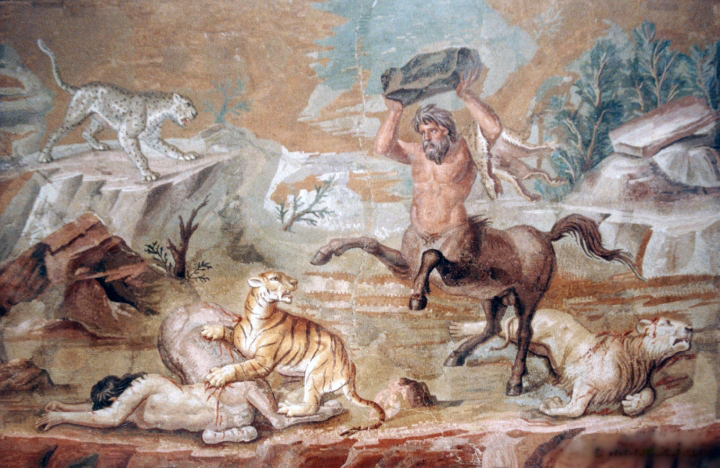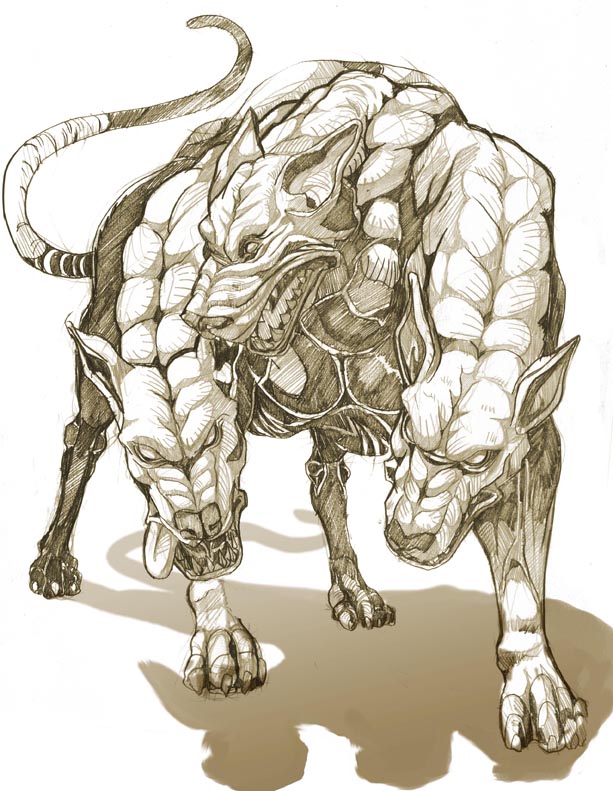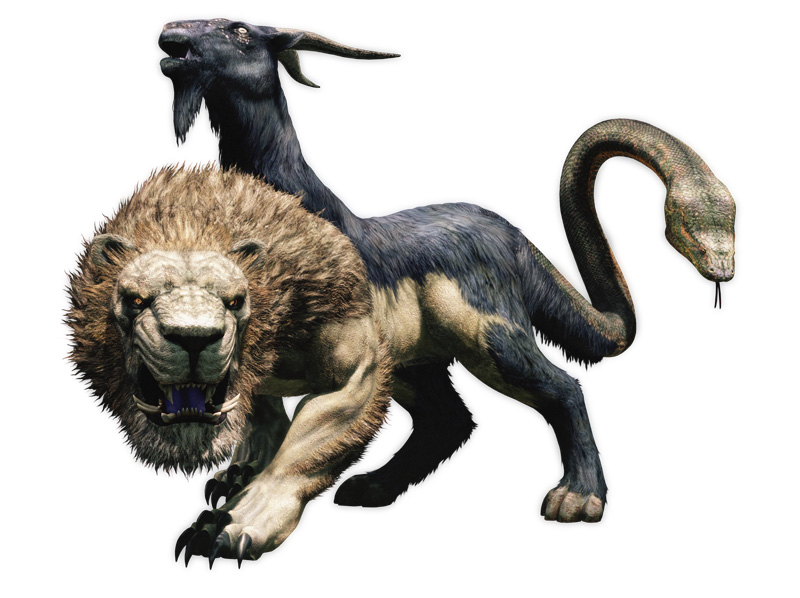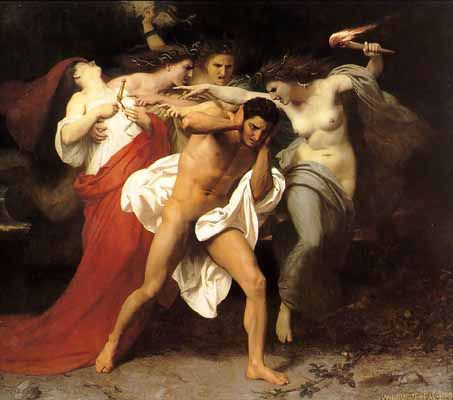Beasts of Greek Mythology
The many intriguing creatures and monsters of mythology play an intrical role in its fascinating appeal. Not included all of the mystical beasts have been added here, but most of the major ones.
Argus

The hundred-eyed character who was given by Hera the task of guarding Io, one of Zeus's many mistresses. Hermes lulled him to sleep and killed him. Hera, distraught, took his eyes and placed them on her favorite bird, the peacock.
Calydonian Boar

The huge boar sent by Artemis to ravage the land of Calydon due to the king's refusal to include her in his annual offerings. The king, Oeneus, requested neighboring cities to help kill the boar, and many heroes - including Peleus and Meleager - participated. The maiden Atalanta wounded the beast, and Meleager finally killed it. Although it had been Atalanta who halted the monster, because she was a woman it was Meleager who was awarded the prize.
Centaurs

The race of half-men, half-horses creatures. They were the product of Ixion's weird lust for Hera. Zeus created a psuedo-Hera, Nemele ["cloud"], who gave birth to Ixion's son Centaurus. This very sick son mated with the horses of Mount Pelion to produce the Centaurs. Centaurs were wild, lusty, and brutal; however, their king was the wise and gentle Chiron who advised, among others, Achilles and Jason. Centaurs may have first have been a misinterpretation of the warriors which came from the East who rode on horseback, at the time foreign to the Hellenes. Chiron was the symbol of man eventually taming the horse, which became a great asset.
Cerberus

The hound of Hades that guarded the entrance to the underworld. He is described with anywhere from two to fifty heads and was the offspring of Typhon and Echidna. Heracles stole Cerberus as one of his labors, and both Aeneas and Odysseus managed to bypass the gigantic dog. Orpheus, the grand musician, soothed the savage beast in order to retrieve his wife Eurydice.
Charybdis

Opposite the monster Scylla, Charybdis was a whirlpool at the northern end of the Straits of Messina which devoured ships.
Chimaera

A fire-breathing beast with a lion's head and body, a serpent for a tail, and a goat's head in the midsection. The chimaera may have represented fiery volcanic mountains where goats and lions dwelt and snakes innundated the foothills. It ravaged Mount Chimaera and was eventually killed by the hero Bellerophon, who shot lead in its mouth. The lead melted in its fiery breath and burnt its insides.
Cyclops

According to Hesiod, the one-eyed sons of Gaia and iron-workers of Hephaestus who also made Zeus's thunderbolts. There are generally three, Brontes [Thunderer], Steropes [Lightener] and Arges [Bright]. The work of Cyclopes is commonly regarded as the explanation for volcanos, and Hephaestus's Roman counterpart, Vulcan [origin of the term "volcano"], certainly backs this notion up. The most famous Cyclop is Polyphemus, who was actually a son of Poseidon but often referred to as "Cyclops". Odysseus encounters him and eventually blinds the one eye.
Echidna

A half woman, half-serpent monster who ate men raw. The daughter of Phorcys and Ceto, she coupled with another half-snake, Typhon, and gave birth to Hydra, Cerberus, and Chimaera.
Erinyes/Eumenides
["kindly ones"]/Furies [Latin name]

The avenging spirits of the dead who relentlessly pursued wrong-doers. Born of the blood of the castrated Uranus, they were, of course, hideous: black teeth, wrinkled faces, and pus-filled eyes.
Giants

They were the sons of Uranus from his castrated blood that appeared almost human except for the fact their legs ended as snakes' tails. They fought the gods at Gaia's insistence and were bound to win as long as they battled only deities. Zeus summoned Heracles, who was mortal [at the time], and the Giants were defeated.
Gorgons/Medusa

Daughters of Phorcys and Ceto, there were three, Medusa being the only mortal. All were once beautiful, but Athena caught Medusa and Poesidon in her temple doing—well, use your imagination!—and Athena transformed the sisters into hideous monsters whose gaze turned men into stone. Medusa was eventually killed by Perseus, and her head placed on Athena's shield. The underlying message is perhaps feminist in nature: the virgin goddess catching an unholy "sacrilege" having sex. The gorgon's gaze may be a metaphor for man becoming petrified and helpless in the presence of a beautiful [or once-beautiful] woman.
The Graiae

Three sisters of the Gorgans who shared one eye between them. Best known as sentinels of the Gorgons, they are represented as old women and the name "graiae" actually means "the gray ones".
Harpies
.jpg)
Winged female demons often associated with Sirens. Most art has Harpies as winged women rather than bird-bodied. Like the sirens, there was originally two, but then another was added, bringing their number to three. Hesiod names them as Aello and Octpete, with Celaeno the later addition. Their names mean storm, swift-flier, and black cloud. They are best known as the tormenters of King Phineus, who was rescued by the Argonauts. They were also the mothers to Achilles's talking horses, Xanthus and Balius. Harpies could be the personification of the unfriendly sea and its accompanying bad weather.
Hydra

Hydra was a snake-like monster born of Echidna and Typhon, with nine grotesque heads. Heracles was sent to kill it for his Second Labor. The problem was, when he cut off one head, two grew back. Heracles's nephew Iolaus managed to counteract this by using firebrands to kill the stumps. However, the nineth head was immortal, but Heracles managed to disable this by burying it deep in the earth. He dipped his arrows in Hydra's blood, which was venomously poisoned.
Ladon

The most famous Greek dragon which guarded the golden apples of the Hesperides, daughters of Atlas. Often described as "sleepy-eyed", he should not be thought of as evil, merely as a beast doing his duty. He is associated with the constellation Draco.
Minotaur

The product of Queen Pasiphae's strange lust for the Cretan Bull. The Minotaur was half-man, half bull and is often depicted with a man's body and bull's head, though there are representations of it with a bull's trunk and man's head and torso. King Minos was so appalled at the offspring that he had the master craftsman Daedalus build an enormous labyrinth for it to hide in. The creature fed upon seven youths and seven maidens sent annually from Athens. The hero Theseus, aided by Minos's daughter Ariadne, slew the monster with its own horn. The Minotaur is perhaps an allegory created by the Athenians for Knossos [Crete] who always harvested a strange fascination for bulls.
Nemean Lion

The child of Selene, the goddess of the moon. After she gave birth to it she dropped it to the earth in horror. It fell in the city of Nemea. When Selene became enraged by the local people for refusing her godhead, she set the monster loose on the village. Heracles flayed the beast for his First Labor and wore the pelt as a cloak.
Pegasus

The beautiful celebrated winged horse of mythology, he was ironically the offspring of Medusa when Perseus decapitated her. Wild and free, he was tamed by the hero Bellerophon with the aid of the famed golden bridle. Winged animals are not of Greek origins, and, like the Sphinx, the myth of Pegasus is probably foreign—most likely it migrated from the East.
Phoenix
The beautiful bird of ancient Assyrian, Greek, and Egyptian legend, and one of my favorites because of its inferences to resurrection and rebirth. Click here for more details and picture.
Python

The serpent belonging to mother earth at her temple in Delphi. The god Apollo slew the beast and claimed the sanctuary for himself.
Scylla

Scylla was a rival of the witch Circe for the love of Glaucus. Circe transformed the maiden into an enormous monster with six dog-heads around her waist. She was transported to the cliffs of the Straits of Messina and devoured sailors who attempted to avoid Charybdis
Sirens

Mesmerizing voices; they are possibly associated with mermaids and the lure of the sea. They would entice sailors with their captivating songs, then eat them raw. Homer writes of two; later the number was three, and eventually myth claimed nine. They committed suicide when a sweeter voice, that of Orpheus, failed to lure any of the Argonauts to their lair.
Sphinx

Generally associated with Egypt, the half-bird, half-woman creature made its appearance in Greek mythology as the scourge of Thebes. It dwelt at the mountain entrance and asked travellers a riddle, and if the they failed, she would eat them. Oedipus was asked the riddle, "What has four legs in the morn, two in the afternoon, and three at sunset?" The answer was man: he is a baby who crawls, an upright adult, and an elder with a cane. Demoralized, the sphinx hurled herself to her death.
Typhon

[Serpents represented the earth, and quite possibly all these half-snake creatures are metaphors for man's battle to dominate the earth.] But back to Typhon: he was the half-man, half snake son of Gaia and Tartarus. He was summoned by Gaia [mother earth] to avenge the defeat of the Titans by the Olympians. Hesiod describes him with a hundred heads, and the gods, upon seeing the monster, fled; only Zeus stood his ground. Typhon cut the sinews from Zeus's hands and feet and threw him into a cave. Hermes and Pan revived the king of gods and mended his wounds. The Fates had weakened Typhon with mortal food, and Zeus managed to dispose of Typhon by crushing him under Mount Etna.
